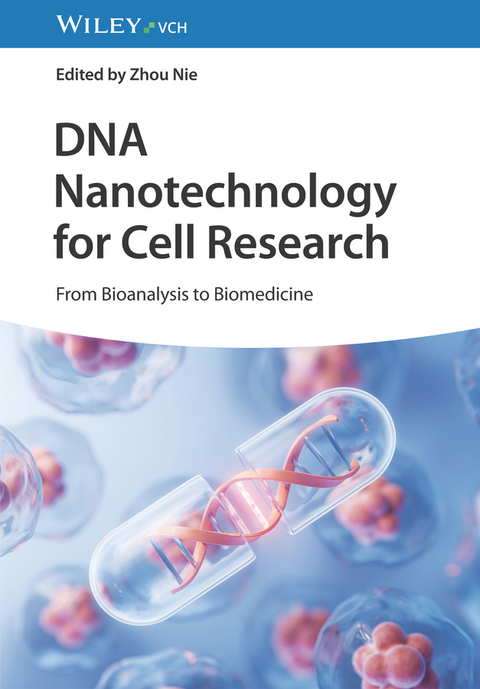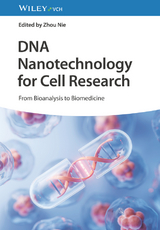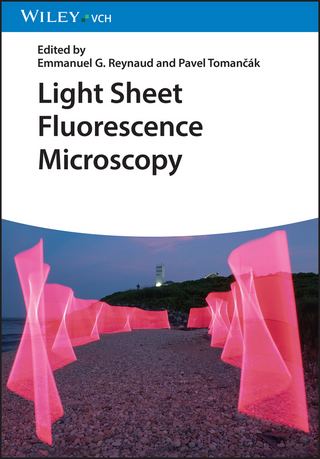DNA Nanotechnology for Cell Research
Wiley-VCH (Verlag)
978-3-527-35173-2 (ISBN)
There is a growing interest to actively develop state-of-art analytical and biological toolkits based on the concept of DNA nanotechnology, which shows great promise in cell research and engineering, one of the core fields in modern biology and medicine. These DNA nanotechnology-based toolkits not only enable exploration of structure, function, and behavior of cells with higher resolution and better specificity, but also allow precise control and intelligent programming of cellular functions for bioengineering and therapeutic purposes.
This book aims to present an overview of DNA nanotechnology with emphasis on a variety of different applications in cell research and engineering. It is divided into four parts.
Part I looks at the use of functional DNA nanotechnology tools to control cell-cell recognition processes.
Part II illustrates the use of DNA-based biochemical sensors to monitor and image intracellular molecules and processes.
Part III examines the use of DNA to regulate biological functions of individual cells.
The final part eludicates the use of DNA nanotechnology for cell-targeted medical applications. This comprehensive book provides both the up-to-date tutorial style overview and the in-depth perspective to benefit the whole DNA-based nanotechnology community.
Zhou Nie is Professor at College of Chemistry and Chemical Engineering, Hunan University. He obtained bachelor degree from Nankai University in 2002, and obtained Ph.D. degree from Institute of Chemistry, Chinese Academy of Science in 2007. Since 2007, he started his career at State Key Laboratory of Chemo/Biosensing and Chemometrics at Hunan University. From 2011 to 2012, he received his postdoctoral training at Purdue University. His current research is focused on the development of new chemical-biological tools for detection and regulation of key factors in crucial biological events, such as cellular signal transduction and transcription regulation. He was awarded by the National Science Fund for Distinguished Young Scholars in 2017, the "Cheung Kong Scholar" for Young Scholars in 2015, the Ten Thousand Talent Program for Young Top-notch Talent in 2014, the National Science Fund for Excellent Young Scholars in 2012, and Chinese Chemical Society Award for Outstanding Young Chemist in 2015. Now he is an associate editor of 'RSC Advances'.
Preface
PART I. DNA Nanotechnology for Cellular Recognition (Cell SELEX, cell surface engineering)
1. DEVELOPING DNA APTAMER TOOLBOX FOR CELL RESEARCH
1.1 Cells and their complexity
1.2 DNA aptamers' characteristics and advantages
1.3 On-demand synthesis and screening of DNA aptamers
1.4 Toward a toolbox of DNA aptamers for cellular applications
1.5 Summary and Outlook
2. BACTERIAL DETECTION WITH FUNCTIONAL NUCLEIC ACIDS: ESCHERICHIA COLI AS A CASE STUDY
2.1 General Introduction on Bacteria
2.2 E. coli
2.3 Conventional Methods for General E. coli Detection
2.4 Biosensors for E. coli Detection
2.5 Conclusion
3. FROM LIGAND-BINDING APTAMERS TO MOLECULAR SWITCHES
3.1 Aptamers can be generated by SELEX
3.2 Various subtypes of SELEX have been invented
3.3 Riboswitches are natural RNA aptamers carrying expression platforms
3.4 Riboswitches use various mechanisms to regulate gene expression
3.5 Riboswitches are potential drug targets
3.6 Fusing aptamer with expression platform to construct artificial RNA switches
3.7 Conclusions
4. DNA NANOTECHNOLOGY-BASED MICROFLUIDICS FOR LIQUID BIOPSY
4.1 Introduction
4.2 DNA nanotechnology-based microfluidics for isolation of circulating targets
4.3 DNA nanotechnology-based microfluidics for release and detection of circulating targets
4.4 DNA-assisted microfluidics for single cell/vesicle analysis
4.5 Summary and Outlook
5. SPATIOTEMPORAL CONTROLLED CELL MEMBRANE ENGINEERING USING DNA NANOTECHNOLOGY
5.1 Background
5.2 DNA Modifications on the External Cell Membrane Surface
5.4 Perspectives
PART II. DNA Nanotechnology for Cell Imaging and Intracellular Sensing
6. METAL-DEPENDENT DNAZYMES FOR CELL SURFACE ENGINEERING AND INTRACELLULAR BIOIMAGING
6.1 Cellular Surface Engineering and Intracellular Bioimaging Show Great Potential in Biological and Medical Research
6.2 Metal-Specific DNAzymes: a Suitable Choice for Artificial Manipulation of Living Cells
6.3 Cell Surface Engineering by Programmable DNAzymes
6.4 Intracellular Imaging of Metal Ions with DNAzyme-Based Biosensors
6.5 Conclusion
7. DNA NANOMOTORS FOR BIOIMAGING IN LIVING CELLS
8. ILLUMINATING RNA IN LIVE CELLS WITH INORGANIC NANOPARTICLES-BASED DNA SENSOR TECHNOLOGY
8.1 RNA Detection and Imaging
8.2 RNA Imaging Based on Direct Hybridization
8.3 RNA Imaging Based on Strand Displacement Reactions
8.4 Signal-amplified RNA Imaging
8.5 Spatiotemporally Controlled RNA Imaging in Live Cells
8.6 Conclusion
9. BUILDING DNA COMPUTING SYSTEM FOR SMART BIOSENSING AND CLINICAL DIAGNOSIS
9.1 DNA computing
9.2 DNA-based computing devices for biosensing
9.3 DNA computing for clinical diagnosis
9.4 Conclusion
10. INTELLIGENT SENSE-ON-DEMAND DNA CIRCUITS FOR AMPLIFIED BIOIMAGING IN LIVING CELLS
10.1 DNA Circuit: The Promising Technique for Bioimaging
10.2 Non-enzymatic DNA Circuits
10.3 Intelligent Integrated DNA Circuits for Amplified Bioimaging
10.4 Stimuli-responsive DNA Circuits for Reliable Bioimaging
10.5 Conclusion and Perspectives
11. DNA NANOSCAFFOLDS FOR BIOMACROMOLECULES ORGANIZATION AND BIOIMAGING APPLICATIONS
11.1 Introduction
11.2 Assembly of DNA-scaffolded biomacromolecules
11.3 Application of DNA nanoscaffold for regulation of enzyme cascade reaction
11.4 DNA nanostructures empowered bioimaging technologies
11.5 Summary and outlook
PART III. DNA Nanotechnology for Regulation of Cellular Functions
12. ADOPTING NUCLEIC ACID NANOTECHNOLOGY FOR GENETIC REGULATION IN VIVO
12.1 Introduction
12.2 Toehold-mediated strand displacement: switching nucleic acids with nucleic acids
12.3 Toehold riboregulators and related systems
12.4 Applying nucleic acid nanotechnology to CRISPR and RNA interference
12.5 Delivery of nucleic acid devices, in vivo production, and challenges for in vivo operation
12.6 Conclusion & Outlook
13. CELL MEMBRANE FUNCTIONALIZATION VIA NUCLEIC ACID TOOLS FOR VISUALIZATION AND REGULATION OF CELLULAR RECEPTORS
13.1 Nucleic Acid-based Functionalization Strategies: From Receptor Information to DNA Probes
13.2 Uncovering Molecular Information of Cellular Receptors
13.3 Governing Cellular Receptors-Mediated Signal Transduction
13.4 Conclusion
14. HARNESSING DNA NANOTECHNOLOGY FOR NON-GENETIC MANIPULATION AND FUNCTIONALIZATION OF CELL SURFACE RECEPTOR
14.1 Introduction
14.2 Principle of DNA-enabled molecular engineering for receptor regulation
14.3 DNA nanodevices for programming receptor function
14.4 Elaborate and intelligent DNA nanodevices reprogramming receptor function
14.5 Conclusions and perspectives
15. DNA-BASED CELL SURFACE ENGINEERING FOR PROGRAMMING MULTIPLE CELL-CELL INTERACTIONS
15.1 DNA Nanotechnology: The Tool of Choice for Programming Cell-Cell Interactions
15.2 Modifying Cell Surface with DNA
15.3 Programming Cell-Cell Interactions by DNA Nanotechnology
15.4 Conclusion
16. DESIGNER DNA NANOSTRUCTURES AND THEIR CELLULAR UPTAKE BEHAVIORS
16.1 Introduction
16.2 DNA Nanotechnology
16.3 Pathways of Cell Endocytosis
16.4 Analysis of DNA Nanostructures' Cellular Uptake behaviors
PART IV. DNA Nanotechnology for Cell-Targeted Medical Applications
17. TOWARDS PRODUCTION OF NUCLEIC ACID NANOSTRUCTURES IN LIFE CELLS AND THEIR BIOMEDICAL APPLICATIONS
17.1 DNA Nanostructures
17.2 RNA Nanostructures
17.3 Applications
17.4 Conclusion
18. ENGINEERING NUCLEIC ACID STRUCTURES FOR PROGRAMMABLE INTRACELLULAR BIOCOMPUTATION
19. DNA SUPRAMOLECULAR HYDROGELS FOR BIOMEDICAL APPLICATIONS
19.1 Introduction
19.2 Classification and Preparation of DNA supramolecular hydrogels
19.3 Biomedical application of DNA supramolecular hydrogels
19.4 Conclusions and perspectives
20. ROLLING CIRCLE AMPLIFICATION-BASED DNA-NANOTECHNOLOGY FOR CELL RESEARCH
20.1 Introduction
20.2 Principle and synthetic methods of RCA
20.3 RCA-based DNA nanotechnology for cell separation
20.4 RCA-based DNA nanotechnology for nucleic acid drug delivery
20.5 Conclusion
21. PRECISE INTEGRATION OF THERAPEUTICS IN DNA-BASED NANOMATERIAL FOR CANCER TREATMENTS
21.1 DNA-based nanomaterials in biomedicines
21.2 Strategies on constructing DNA-based DDSs
21.3 Precise integration of therapeutics into DNA-based DDSs to achieve synergistic cancer treatment
| Erscheinungsdatum | 20.03.2024 |
|---|---|
| Verlagsort | Weinheim |
| Sprache | englisch |
| Maße | 170 x 244 mm |
| Gewicht | 1182 g |
| Einbandart | gebunden |
| Themenwelt | Medizin / Pharmazie ► Medizinische Fachgebiete ► Biomedizin |
| Naturwissenschaften ► Biologie ► Biochemie | |
| Naturwissenschaften ► Chemie ► Organische Chemie | |
| Technik ► Maschinenbau | |
| Schlagworte | Biomolecules (DNA, RNA, Peptides, etc.) • Biomoleküle (DNA, RNA, Peptide) • Biotechnologie • Biotechnologie i. d. Biowissenschaften • Biotechnology • Biowissenschaften • Chemie • Chemistry • DNA • DNS • Life Sciences • Nanobiotechnologie • nanobiotechnology • Nanotechnologie • nanotechnology |
| ISBN-10 | 3-527-35173-6 / 3527351736 |
| ISBN-13 | 978-3-527-35173-2 / 9783527351732 |
| Zustand | Neuware |
| Informationen gemäß Produktsicherheitsverordnung (GPSR) | |
| Haben Sie eine Frage zum Produkt? |
aus dem Bereich




